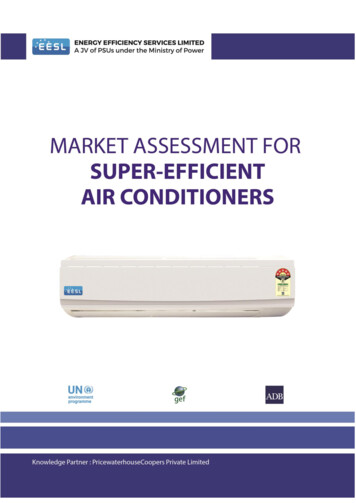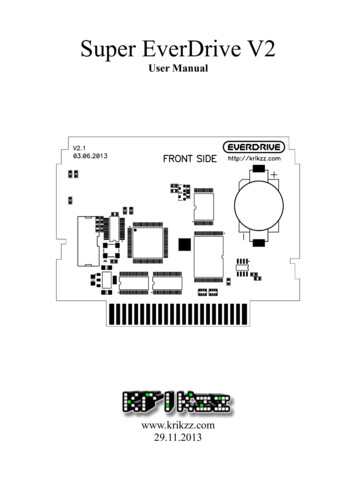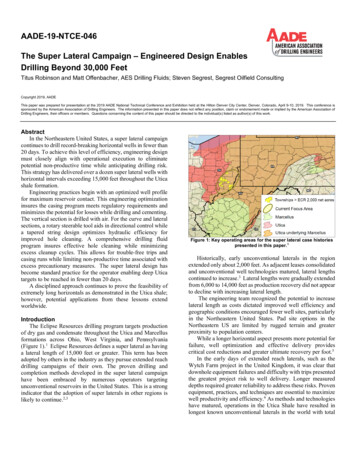
Transcription
1Error! No text of specified style in document. Error! No text of specified style in document.
Market Assessment for Super-Efficient Air ConditionersEESL EESL India 2021Published by EESL IndiaAny reproduction of this publication in full or part must mention the title and credit the above-mentionedpublisher as the copyright owner.AcknowledgmentsEESL India and PwC India are grateful to all experts and specialists for providing insights during the preparationof this report. We would like to thank the Voltas Haier, O.G Heavy Duty, Godrej, MPCL Industries Ltd., Carrier,Trane, Daikin, BSES Yamuna Power Limited (BYPL), Tecumseh, UL, Intertek for their valuable inputs for thereport.Project TeamEESL IndiaS P Garnaik, Girja Shankar, Dr. Anant Shukla, Manoj Kumar M, Moumita Chandra, Brijesh Kumar Gautam,Nitesh Kumar GuptaPwC IndiaRajeev Ralhan, Bhaskar Jyoti Nath, Gurraj Bhinder, Sorabh Singhal, Kanishk SuriDisclaimer:The report has been jointly prepared by EESL India and PwC India with inputs based on conversations, publiclyavailable information and information gathered from different organisations. EESL India and PwC India disclaimany liability for the use that may be made of the information contained in this report. While the key organisationsexperts listed in the Acknowledgements and Appendix have provided significant inputs for the development ofthis report, their participation does not necessarily imply endorsement of the report’s contents or conclusions.2
Market Assessment for Super-Efficient Air ConditionersEESL3
Market Assessment for Super-Efficient Air ConditionersEESL4
Market Assessment for Super-Efficient Air ConditionersEESL5
Market Assessment for Super-Efficient Air ConditionersEESLTable of Contents1.Executive Summary .112. Room Air Conditioners – Overview of technology, performance and efficiency trends.131.1. Air-conditioning principles . 131.1.1. Thermal Comfort . 131.1.2. Principle-Vapour compression . 131.2. Overview of Indian RAC market . 141.2.1. RAC - Basis type and definition. 141.2.2. Major players and market size . 161.2.3. RAC import / export trend . 171.2.4. Market share – Basis type and technology . 181.2.5. Market share – Basis efficiency . 191.2.6. Market share – Basis refrigerant . 191.2.7. Market Share- Basis tonnage . 201.2.8. Energy performance considerations . 201.2.9. Test standards for RAC in India . 222. Key RAC market trends .272.1. RAC market in India . 272.1.1. RAC sales projections . 272.1.2. Refrigerant use in RAC. 272.2. RAC efficiency trends. 282.2.1. Factors effecting RAC efficiency . 302.3. IoT based applications in RAC’s . 313. Overview of global SEAC market .323.1. Global RAC landscape . 323.1.1. Technology trends . 333.1.2. Refrigerant trends. 333.1.3. Efficiency trends . 353.2. Applicable international standards . 363.2.1. Efficiency thresholds and most efficient RAC examples in China, South Korea, Japan and Europe . 374. Review of National and International policies and programs.414.1. National policies/ programs for promoting energy efficient in RAC . 414.1.1. India Cooling Action Plan (ICAP) . 414.1.2. BEE’s Standard and Labelling program. 414.1.3. Energy Conservation Building Code (ECBC) . 414.1.4. EESL Super-Efficient Air-conditioner Programme . 426
Market Assessment for Super-Efficient Air ConditionersEESL4.1.5. AC Replacement Scheme by DISCOMS under the DSM program . 434.2. International policies/ programs for promoting energy efficient in RAC . 444.2.1. HCFC Phase out management plan under Montreal Protocol. 445. Supply Chain of RAC .475.1.1. Compressor manufacturing, Import and Export . 485.1.2. RAC manufacturing works in India . 505.2. Growth drivers . 516. Assessment of Refrigerants used in RACs.536.1. Brief overview and history on refrigerants used in RACs . 536.2. Current status of refrigerants used in the Indian RAC market . 556.3. Expected usage and refrigerant transition in the next decade . 556.4. Environmental impacts of the RACs . 566.5. Cost comparison analysis of high GWP vs. low GWP . 576.6. Incentives/ subsidies required to migrate to low GWP refrigerants . 587. Cost components of an RAC .597.1. Component wise pricing of super-efficient AC’s . 597.2. Price – efficiency analysis . 617.2.1. Savings / payback analysis of different RAC models . 638. Financing options for SEAC.659. Business models and SWOT analysis .6710. Gap analysis on Super-Efficient AC programs.7110.1. Challenges and barriers in the implementation of Super-Efficient AC program . 7110.2. External enablers required to advance SEAC penetration . 7210.3. Promotion and educational campaigns for spreading awareness of SEAC . 73Annexure – 1 . 75References . 767
Market Assessment for Super-Efficient Air ConditionersEESLList of TablesTable 1 ISEER rating of split AC CY' 18-21Table 2 ISEER rating of window AC CY' 18-21Table 3:GWP and ODP values of RAC refrigerantsTable 4: Bin hours against each bin temperatureTable 5: Tests under IS 1391Table 6: Cooling capacity and power consumption test conditionTable 7: Maximum power consumptionTable 8: ISEER Measurement testing conditionsTable 9:Window AC Star Rating Plan CY 09-11Table 10:Split AC Star Rating Plan CY 09-11Table 11:Window AC Star Rating Plan CY 12-13Table 12:Split AC Star Rating Plan CY 12-13Table 13:Window AC Star Rating Plan CY 14-17Table 14:Split AC Star Rating Plan CY 14-17Table 15:Window AC Star Rating Plan CY 18-21*Table 16:Split AC Star Rating Plan CY 18-21*Table 17:Window AC Star Rating Plan CY 22-24*Table 18:Split AC Star Rating Plan CY 22-24*Table 19: Best in class RAC in IndiaTable 20: Technological changes to increase the ISEER in HVAC systemsTable 21: Refrigerant trends in RACTable 22: Efficiency trends in RACTable 23: Standards adopted for RAC labelling by various countriesTable 24: Efficiency Threshold values in ChinaTable 25: Example of efficient RAC model in ChinaTable 26: South Korea's energy efficiency standards and labels for split ACTable 27:Example of efficient RAC model in KoreaTable 28: Japan’s Top runner program standard in APF for RAC'sTable 29:Example of efficient RAC model in JapanTable 30: EU's energy efficiency classesTable 31: Eco Design requirements for RAC's in EUTable 32:Example of efficient RAC model in EuropeTable 33: Minimum requirements for RAC in ECBC BuildingsTable 34: Compressor manufacturing trends FY 17Table 35: Import / Export of RAC compressors by region in 2018-19Table 36: Compressor Manufacturers in IndiaTable 37: Ratification of various agreement by IndiaTable 38: Phase-out schedule of India as per Montreal ProtocolTable 39: Refrigerant - Ashrae FlammabilityTable 40: Emission during various life stage of refrigerantTable 41: Overview of emission from RAC sectorTable 42: Cost comparison of various AC models as per refrigerants in INRTable 43 Cost components of an RACTable 44: Cost - Efficiency analysis of 1.5 TR Split ACTable 45: Price discovery of 1.5 TR Split RACTable 46: Savings payback analysisTable 47: Source and type of 58
Market Assessment for Super-Efficient Air ConditionersEESLList of FiguresFigure 1:P-H Diagram of a vapor compression cycleFigure 2: Classification of RACFigure 3:Key RAC market players in IndiaFigure 4: RAC Sales from YOYFigure 5: RAC ImportFigure 6: RAC ExportFigure 7 : RAC indegenous production / assemblyFigure 8: RAC market share by typeFigure 9: RAC market share by technologyFigure 10: Room AC sales by star rating (2017-18)Figure 11: Room AC sales by star rating (2018-19)Figure 12: RAC sales by refrigerants (2017-18)Figure 13: RAC sales by refrigerants (2018-19)Figure 14: RAC sales by tonnage (FY 16-17)Figure 15: RAC sales by tonnage (FY 17-18)Figure 16: Power and speed relation as per cube lawFigure 17: Projected Room AC salesFigure 18 Installed Refrigerant stock in 2017Figure 19: Expected installed refrigerant stock in 2027Figure 20: Global RAC Demand in 2018-19Figure 21: AC Penetration rate in 2018-19Figure 22: Country wise Fixed speed and Variable speed split type RACs 2017-18Figure 23: Country wise HFC and HCFC mix for split type RAC FY 17Figure 24: ICAP – Goals for space coolingFigure 25: ISEER value comparison in RACFigure 26: GWP value comparison in RACFigure 27: CFC phase out ScheduleFigure 28: HCFC consumption phase out ScheduleFigure 29: Montreal Protocol and its amendmentsFigure 30: RAC supply chain in IndiaFigure 31: Compressor import in IndiaFigure 32:Phase down schedule of HFC for IndiaFigure 33: Trend of refrigerant in next five yearsFigure 34: Environmental impacts of RAC'Figure 35: Factors effecting RAC efficiencyFigure 36: Relationship ISEER, material cost and cost to consumerFigure 37: Types of financeFigure 38: SWOT Analysis of upfront modelFigure 39: SWOT Analysis deferred paymentFigure 40: SWOT Analysis on bill financingFigure 41: SWOT Analysis of ESCO modelFigure 42: SWOT Analysis buyback of old efficient ACFigure 43: SWOT Analysis ECO friendly scrapping 2333441434346454547495455566163656768686969709
Market Assessment for Super-Efficient Air ConditionersEESLAbbreviations and YOYAnnual Performance FactorAmerican Society of Heating, Refrigerating and Air conditioningBureau of Energy EfficiencyBeaurea of Indian StandardsCompound Annual Growth RateChlorofluorocarbonCooling Seasonal Energy ConsumptionCooling Seasonal Performance FactorCooling Seasonal Total LoadEnergy Conservation Building CodeEnergy Efficiency RatioEnergy Efficiency Services LimitedEquated Monthly InstallmentEnergy Management SystemsEnergy Service CompanyGlobal Warming CFC Phase-out Management PlanHarmonized systemIndia Cooling Action PlanInternet of ThingsIndian Seasonal Energy Efficiency RatioMinimum Efficiency Performance StandardsManagement Information SystemMinistry of Environment, Forest & Climate ChangeMicro, Small and Medium EnterprisesNational Accreditation Board for Testing and Calibration LaboratoriesOzone Depletion PotentialOzone Depletion SubstancesOriginal Equipment ManufacturerPressure-EnthalpyRoom Air ConditionerRevolutions Per MinuteStandards and LabellingSeasonal Coefficient of PerformanceState Expert Appraisal CommitteeSeasonal Energy Efficiency RatioUnited LaboratoriesVariable Frequency DriveYear on Year10
Market Assessment for Super-Efficient Air ConditionersEESLExecutive SummaryIndia is the second fastest growing economy in the world. Increasing income levels, urbanization and risingtemperatures have led to a growth in demand for room air conditioners (RAC). During the last five years theRAC market has grown at a steep Compound Annual Growth Rate (CAGR) of 18% to touch 7.7 million salesunits in 2019-201. This number is expected to exceed the 20 million mark by 2027, with an inevitable surge inthe electricity requirement to run this RAC stock. In 2017-18 RAC’s constituted around 40% (56 TWh) of totalenergy consumption in urban homes in India, which is expected to increase to 50% (215 to 385 TWh) by 203738 in the reference scenario2. The growing RAC market will also raise the peak demand on the alreadyoverstressed electricity grids, exacerbating blackouts and brownouts.To manage the envisaged electricity demand, RAC efficiency has become one of the priority areas for theGovernment of India (GOI). The Indian Cooling Action Plan (ICAP) estimates that the electricity consumption ofthe RAC sector can be reduced by 33% (135 to 285 TWh) compared to the 2037-38 reference scenario bysuitable interventions.Several steps have been taken by GOI to regulate the efficiency of the RAC sector. One significant step in thisdirection was Bureau of Energy Efficiency’s (BEE) Standards and Labelling program for RAC. BEE launchedits standards and labelling program for RAC in 2007 to regulate and ratchet up efficiency levels in this sector.BEE has periodically revised the RAC efficiency norms resulting in an overall efficiency improvement of 36%3compared to the baseline value in 2007. However, there is still a potential for improvement.Another significant dimension of RAC use is the environmental impact such as Ozone depletion and directglobal warming caused by the refrigerants used in them. Although today’s RACs use refrigerants which haveZero ODP (ozone depletion potential) and low-GWP (Global warming potential) compared to their oldercounterparts, there is a further opportunity to transit to natural or HFO’s (Hydro-fluoro Olefin) refrigerants withnegligible global warming potential.Given the benefits of promoting efficiency in RAC sector, the Global Environment facility (GEF) is supportingEnergy Efficiency Services Limited (EESL) to conduct a market assessment study for such super-efficient airconditioners (SEAC) in India. The objective of the study is to explore efficient technologies in RAC’s which canreduce the energy requirements and environmental impacts associated with RAC use. This is not onlyparamount for sustainable growth of the Indian economy but also to ensure compliance with internationalcommitments such as Montreal Protocol.The report provides a comprehensive overview of trends in Indian and global RAC market. Extensive literaturereview and desk research was done to capture national and international trends on efficiency, refrigerant useand standard labelling programs. This activity was parallelly followed by stakeholder consultations and surveyquestionnaire for expert opinions and bridging any gaps in data. RAC Component pricing, financingmechanisms, business models and go to market strategies have also been analyzed to scale up the deploymentof Super-Efficient air conditioner (SEAC) program in India.Chapter 1 starts with a brief on air conditioning principles and then gives an overview of Indian air conditioningmarket, import / export statistics, technology trends in terms of (refrigerant, efficiency). Chapter 1 ends with keyinsights on the testing standards and labelling program for RACs in India.1As per our stakeholder interactions and analysisIndian Cooling Action Plan3 BEE Star labeled appliances211
Market Assessment for Super-Efficient Air ConditionersEESLChapter 2 and 3 give an overall picture of the demand/ supply scenario in global RAC markets such as China,Japan, Korea, North America and Europe. They also detail the efficiency, refrigerant and technology trendsprevalent in these markets. This chapter also provides a comparative of the test standards applicable in China,Korea and Japan.Chapter 4 gives a snapshot of various policy regulations and programs in place for promotion of efficient AC’sin India.Chapter 5 details the supply chain analysis of major RAC components and domestic manufacturing capabilityChapter 6 gives the regulatory landscape of refrigerant use in RAC’s. It summarizes how the refrigerants havetransitioned over time from High ODP and GWP to Zero ODP and low GWP under the Montreal protocol andits subsequent amendments.Chapter 7 gives an insight on the cost components of an RAC and also gives the details of various costcomponents which contribute to the final cost of the RAC.Chapter 8 and 9 detail various financing mechanisms and business models for promoting the Super-efficientAC programs.Chapter 10 gives the barriers in the uptake of super-efficient air conditioners and recommends its mitigationmeasures12
Market Assessment for Super-Efficient Air ConditionersEESL1. Room Air Conditioners – Overviewof technology, performance andefficiency trends1.1. Air-conditioning principles1.1.1. Thermal ComfortAir conditioning systems are primarily used for improving thermal comfort of its occupants. American Society ofHeating, Refrigerating and Air conditioning (ASHRAE) defines “thermal comfort as a condition of mind thatexpresses satisfaction with the thermal environment”. Thermal comfort varies from person to person and isbroadly dependent on 6 parameters 1.2.3.4.5.6.Metabolic rate;Clothing insulation;Radiant temperature;Air temperature;Humidity limits; andAir speed.The purpose of air conditioning is to achieve thermal comfort for its occupants by controlling the last 3parameters (factors 1 and 2 are considered uniform for an application and factor 3 indirectly depends upon thelast three factors). Since thermal comfort is relative varying from person to person, ASHRAE’s standard 55 and62.1 specify the range of these parameters which areacceptable thermal conditions for its occupants (indifferent applications). The parameter range is asfollows – Air temperature – Between 67 (19.4 Deg.C)to 82 (27.7 Deg.C)Humidity – 65% Or lessAir Speed – 0.2 m/s to 1.5 m/sDepending on the application (office, gym, auditoriumetc.), a certain combination of these parameters willprovide thermal comfort to its occupants. Theseparameters are predominantly controlled by airconditioning appliances (such as room air-conditioner(RAC), chillers, VRF/VRV, package DX), all of whichwork on the principle of vapour compression.Figure 1:P-H Diagram of a vapor compression cycle1.1.2. Principle-Vapour compressionVapour Compression involves circulating a working fluid (refrigerant in this case) that absorbs heat from theplace to be conditioned and rejects it elsewhere. The refrigerant goes through 4 stages in a vapor compressioncycle for producing the refrigerating effect:13
Market Assessment for Super-Efficient Air ensationExpansionIn each stage of the cycle the refrigerant goes through various thermodynamic state. These thermodynamicstates of the refrigerant are depicted on a PH (Pressure-Enthalpy) diagram as shown in figure 1. Thesaturation curve of the refrigerant gives the demarcation of its 3 states i.e. Liquid, Liquid Vapor, Vapor.1. Evaporation: Evaporation occurs in the evaporator of an air conditioner. Owning to the low pressureof the refrigerant in the evaporator coils, it boils at a very low temperature. The heat required to boil therefrigerant comes from the space to be cooled. This phenomenon occurs between point 6 and 7 of thePH diagram. As the refrigerant boils, the ratio of vapour in the liquid vapor mixture of refrigerantincreases and it becomes 100% vapor at point 7 (also known as saturated vapor). Super heating occursbetween point 7 and 1 and ensures no liquid refrigerant is sent back to the compressor as the liquidcan damage it.2. Compression: Compression occurs in the compressor of an air conditioner. On the PH diagram it isdepicted between point1 and point 2 in figure 1. It compresses the low-pressure, low temperaturerefrigerant gas into a high-pressure high temperature superheated gas.3. Condensation: The condenser rejects all the heat absorbed by the refrigerant in the evaporator andcompressor. The high pressure and super-heated gas is cooled in the condenser. First the superheatof the gas is removed to bring down the temperature of the vapour to its saturation temperature. Theremoval of superheat is done in the topmost portion of the condenser coils. This process is shown inpoint 2 and 3 in the PH diagram. At point 3 the condenser starts changing the phase of refrigerant fromvapour, to Liquid Vapor and finally to saturated liquid by the time it reaches point 4. The refrigerant isthen subcooled (as depicted between points 4 and 5) to ensure that only liquid refrigerant enters theexpansion device.3. Expansion: The expansion valve reduces the liquid refrigerant under high pressure / high temperatureto low pressure / low temperature (as depicted between point 5 and 6 of the figure 1) refrigerant for theevaporator. The temperature/ pressure reduction is achieved by regulating the orifice of the expansion.This cycle is repeated all over again.At any given condition the heat removed by the evaporator depicted from point 6 to 7 on the PH diagram signifiesthe cooling capacity of the air conditioner. The work done in compressing the refrigerant from point 1 to 2signifies the electrical power required by the compressor. The ratio of these, gives the efficiency of the airconditioning system.1.2. Overview of Indian RAC market1.2.1. RAC - Basis type and definitionRoom air conditioner (RAC) category in India comprises of Window type and Split type air conditioners up to acooling capacity of 18 kW. This categorization is as per the standards for air-conditioners laid out by Bureau ofEnergy Efficiency (BEE). IS 1391 are the Indian standards for RAC. IS 1391 part 1 and part 2 are applicable forwindow AC and Split AC respectively.The definitions of window and split AC are as follows:14
Market Assessment for Super-Efficient Air ConditionersEESLWindow AC: An encased assembly designed as a self-contained unit primarily for mounting in a window orthrough the wall or as a console. It consists of compressor, heat exchangers and air handling system installedin one cabinet.Split AC: A split air conditioner consists of an outdoor unit and an indoor unit. The indoor unit is installed insideon the wall or the ceiling, while the outdoor unit is installed on the exterior of the wall. The split AC unit consistof compressor, heat exchangers, fan motors, and air handling system installed in two separate cabinets.The categorisation based on type of RAC’s is depicted in the figure below:Type of RAC(Upto 18 kWcooling capacity)SplitWindowFloor standingcassetteHi wallFigure 2: Classification of RACWindow AC’s available in the market are below 7 kW 4 ( approx. 2 TR) in cooling capacity, whereas Split ACcategory extends upto 18 kW (approx. 5.1 TR) with 3 different product types as explained below Hi-wall Units- fall below 10.5 kW ( approx. 3TR) cooling capacity Cassette AC- Majority of cassette units sold in the market have cooling capacity between 10.5 kW(approx. 3TR) to 18 kW (approx. 5.1 TR). Very few are sold in less than 10.5 kW cooling capacity size.The indoor units of these AC’s are mounted on the ceiling.Floor Standing- Majority of floor standing units sold in the market have cooling capacity between 10.5kW to 18 kW. Very few are sold in less than 10.5 kW cooling capacity size. As the name suggest theindoor units of these AC’s are kept on the floor.Room air conditioners can further be classified based on usage: Cooling only and both heating / cooling.India, especially north India, experiences extreme weather conditioners. While summers are unimaginablewithout air conditioners, winters without heaters can be harsh. Manufacturers thus have products that servethe function of both cooling and heating. These products are called reversible type.41TR 3.516 kW15
Market Assessment for Super-Efficient Air ConditionersEESLThe reversible type products are not very common in India with a miniscule market share. However reversiblesplit AC is more common than their reversible window counterpart. There are no standards for heating inIndia, therefore reversible products are rated based on their cooling efficiency.1.2.2. Major players and market sizeThe RAC market in India presents a fragmented
Market Assessment for Super-Efficient Air Conditioners EESL 9 List of Figures Figure 1:P-H Diagram of a vapor compression cycle 13 Figure 2: Classification of RAC 15 Figure 3:Key RAC market players in India 16 Figure 4: RAC Sales from YOY 16 Figure 5: RAC Import 17 Figure 6: RAC Export 17 Figure 7 : RAC indegenous production / assembly 18 Figure 8: RAC market share by type 18










